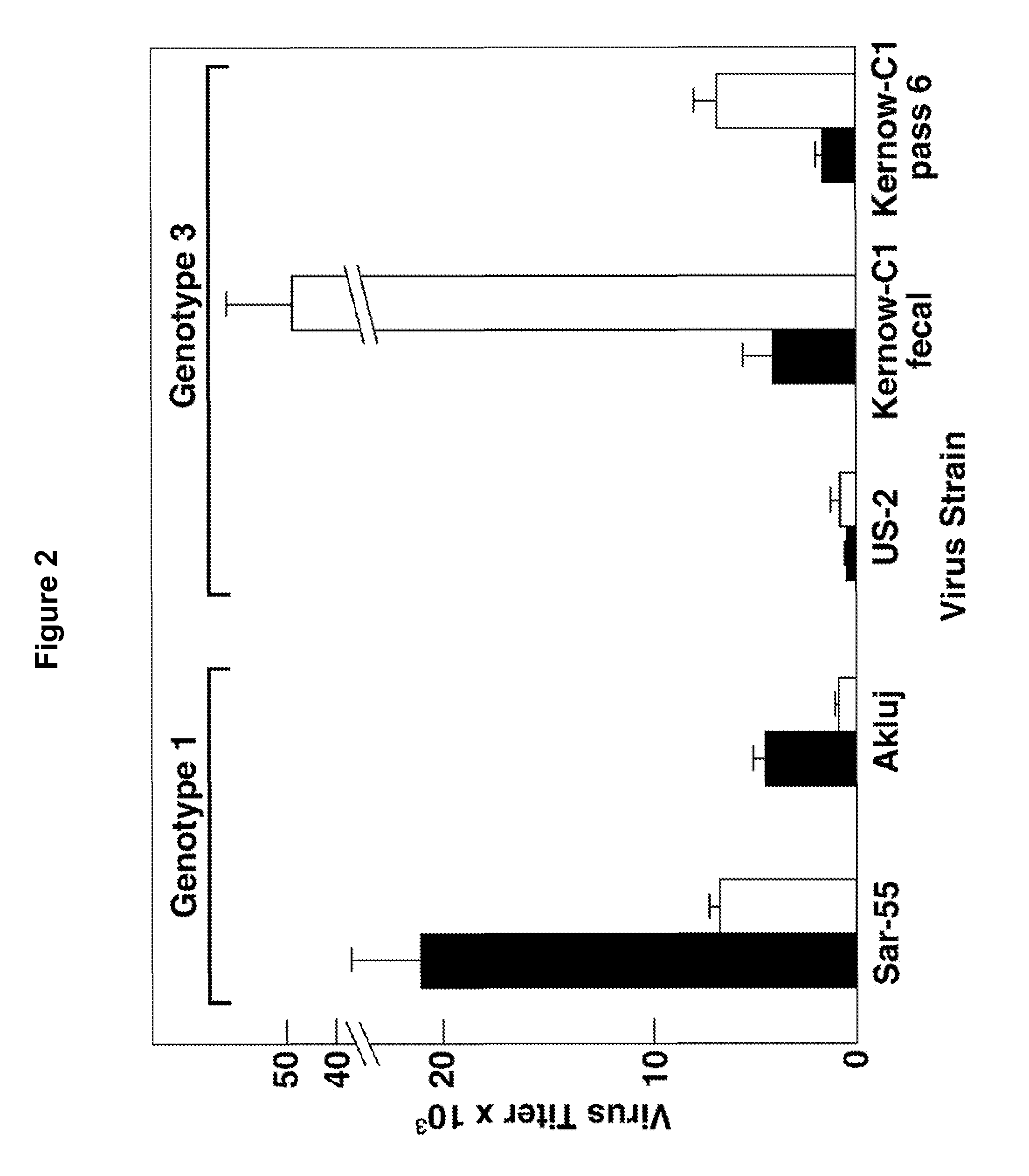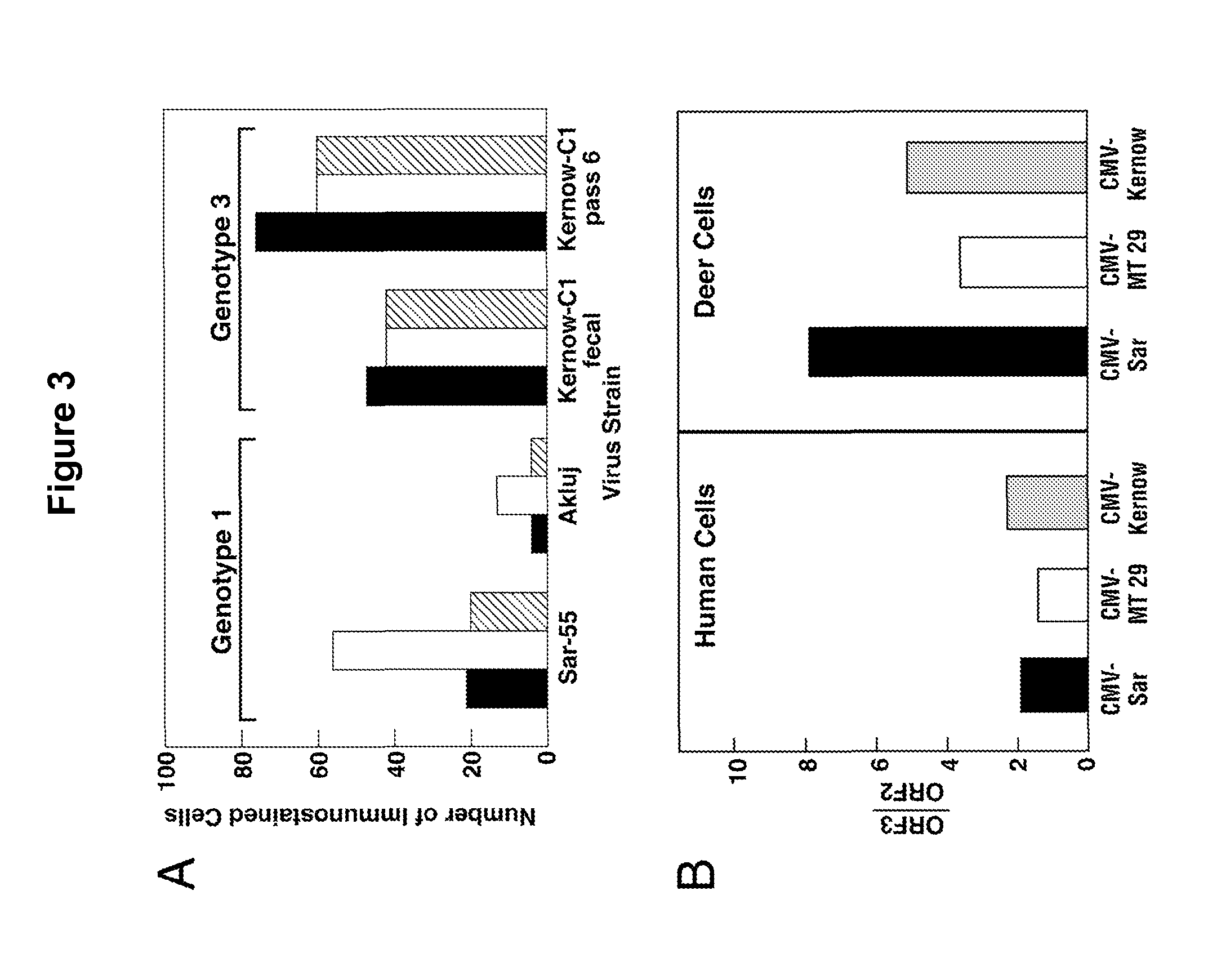Infectious hepatitis e virus genotype 3 recombinants
a technology of infectious hepatitis e virus and recombinant cells, which is applied in the direction of antibody medical ingredients, peptide sources, drug compositions, etc., can solve the problems of inefficiency inability to understand the transmission route, and limited effect of hev cell cultur
- Summary
- Abstract
- Description
- Claims
- Application Information
AI Technical Summary
Benefits of technology
Problems solved by technology
Method used
Image
Examples
example 1
Genotype 3 Infection of Cells from 10 Different Species
[0109]Although certain genotype 3 and 4 strains are known to infect swine and / or deer as well as humans, there are no virus-cell culture systems suitable for exploring host range parameters. In an effort to develop such a system, genotype 3 Kernow-C1 strain of HEV was semi-purified from the feces of an HIV-1 patient infected with HEV (5). The patient had been chronically infected with HEV for two years when his feces were collected and found to contain approximately 1010 viral genomes per gram. The virus was inoculated onto 5 human and 1 rhesus cell line and 7 days later cells were stained for immunofluorescence microscopy with antibodies to ORF2 capsid protein and to ORF3 protein: since these viral proteins are translated from a subgenomic mRNA, their presence indicates viral RNA synthesis has occurred. Infected foci were found in all 6 cultures but the number of foci was more than 7.5 fold higher in HepG2 / C3A human hepatoma ce...
example 2
HepG21C3A-Adapted Virus and Host-Cell Recombination
[0116]The RT-PCR consensus sequence of the virus in the feces and at passage 6 was determined. Sixteen amino acid differences (10 in ORF1, 5 in ORF2 and 1 in ORF3) along with an in-frame insert of 58 amino acids in the hypervariable region (HVR) of ORF1 (22) differentiated pass 6 from the fecal virus (Table 4). A Blast search identified the inserted sequence as belonging to the ribosomal 517e superfamily which is highly conserved across species. One hundred sixty seven of 170 nucleotides and 53 of 57 amino acids were identical to those in the human ribosomal protein S17 (GenBank DQ896701.2) (FIG. 4) compared to only 155 of 171 nucleotides in the swine S17 protein (AY5500731.1). RT-PCR with paired HEV and insertion sequence primers detected viral genomes with the insertion in the original fecal suspension indicating that a double-recombination event had occurred either in the patient or in a previous host. It is noteworthy that the r...
examples 1 and 2
[0137]The Kernow-C1 strain is the first HEV strain from a chronically-infected patient to be grown in cell culture; among other unique characteristics, it exhibited an exceptionally broad host range. Not only is it the first HEV strain found to infect cells from non-primate species, the range of cross-species infections spanning animals as diverse as chickens and mice was totally unexpected and would not have been predicted based on current knowledge. Note that none of the viruses used have been plaque purified so each inoculum likely represents a mixed population; therefore, the virus infecting primate cells may differ substantially from that infecting cells of other species. The effects of biological diversity and cell culture-acquired mutations should be possible to study once an infectious cDNA clone with robust replication capacity is constructed.
[0138]Although the pass 6 virus produced sufficient extracellular virus to permit experiments previously impossible, the low specific...
PUM
| Property | Measurement | Unit |
|---|---|---|
| Fraction | aaaaa | aaaaa |
| Fraction | aaaaa | aaaaa |
| Fraction | aaaaa | aaaaa |
Abstract
Description
Claims
Application Information
 Login to View More
Login to View More - R&D
- Intellectual Property
- Life Sciences
- Materials
- Tech Scout
- Unparalleled Data Quality
- Higher Quality Content
- 60% Fewer Hallucinations
Browse by: Latest US Patents, China's latest patents, Technical Efficacy Thesaurus, Application Domain, Technology Topic, Popular Technical Reports.
© 2025 PatSnap. All rights reserved.Legal|Privacy policy|Modern Slavery Act Transparency Statement|Sitemap|About US| Contact US: help@patsnap.com



